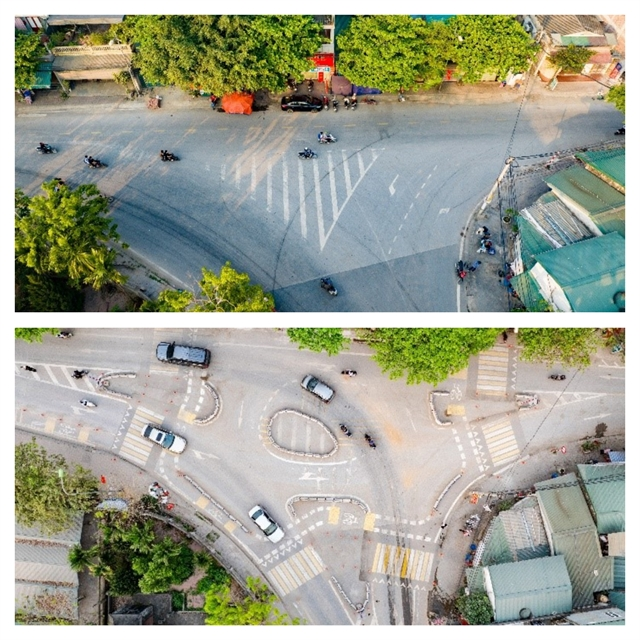The pilot programme targets several schools in the districts of Hà Đông, Bắc Từ Liêm, and Quốc Oai.

Sài Sơn School cluster, Quốc Oai District, before and after the renovation.
HÀ NỘI -- The Hà Nội Department of Transport (DOT), with support of the Partnership Programme for Healthy Cities (PHC), the Bloomberg Philanthropies Initiative for Global Road Safety (BIGRS) and the Hà Nội People's Committee, has launched a pilot programme to enhance traffic safety around schools.
This pilot programme targets several schools in the districts of Hà Đông, Bắc Từ Liêm, and Quốc Oai. Notably, the Xuân Đỉnh School cluster in Bắc Từ Liêm, Nguyễn Du Primary School in Hà Đông, and the Sài Sơn School cluster in Quốc Oai. The Global Designing Cities Initiative (GDCI) have provided technical support and expertise in designing the safety measures.
The pilot programme introduced several infrastructure improvements to reduce speeding and enhance safety in school zones. For example, 30 km/h speed limit signs were installed at school gates areas. Raised crosswalks were installed to ensure safe pedestrian crossings. Pedestrian crossings were repaved with white and yellow lines to increase visibility.
In areas lacking sidewalks, walkways were expanded and marked with reflective plastic cones. Parents’ parking areas were reorganized to reduce congestion. Roundabouts and refuge islands were installed at intersections to manage traffic flow and improve pedestrian safety. Dedicated cycling lanes were created to ensure safe routes for students riding bicycles (at Sai Son school cluster).
In parallel with infrastructure improvements, the Hà Nội Department of Transport also engaged in extensive communication efforts. This included announcing the pilot programme through press and media and coordinating with schools to educate teachers and parents on safety measures. The department also involved traffic inspectors and police to manage traffic and guide the public during peak hours.
The programme's initial results, assessed through surveys, pictures, and videos by GDCI, indicate significant improvements in traffic safety and public perception.
Post-renovation surveys at Sài Sơn School cluster show a notable decrease in vehicle speeds with no reported crashes or collisions. Student utilisation of sidewalks increased by 18 per cent, while there was a 5 per cent rise in cycling to the site and a 4 per cent increase in daily cycling for commuting. Public perception of safety improved significantly, with 27 per cent more respondents feeling very safe, 18 per cent more considering the street safe for children, and a 16 per cent increase in parental comfort allowing children to walk and bike alone. Additionally, cycling mode share increased by 4.5 per cent, and motorcycle usage decreased by 5.5 per cent. Pedestrian behaviour improved, with a 43.4 per cent reduction in roadbed walking and a 31.6 per cent increase in using marked crossings.
At Nguyễn Du Primary School, vehicle speeds decreased, and no crashes or collisions were reported post-renovation. Student sidewalk usage increased by 41 per cent. The number of road users choosing cycling increased by 18.9 per cent, with a 20.6 per cent rise in daily bicycle commuting. The project attracted 31.1 per cent more daily visitors, with 46.5 per cent of users spending over two hours on the site. Safety perceptions improved significantly, with 49 per cent more respondents feeling very safe and 86.7 per cent considering the street exceptionally safe for children. Parental confidence increased, with 70.6 per cent expressing strong comfort in allowing their children to walk and bike alone. Pedestrian behaviour also improved, with a 5.3 per cent reduction in roadbed walking and a 14.5 per cent decrease in unmarked crossing use.
In the Xuân Đỉnh School cluster, vehicle speeds decreased, and no crashes or collisions were reported post-renovation. Student street usage increased by 22 per cent. There was a significant shift towards sustainable transportation, with a 25 per cent increase in cycling and a 14 per cent rise in walking to access the site, while motorcycle usage decreased by 35 per cent. Safety perceptions among 165 respondents improved, with 51.5 per cent feeling very safe and 47.5 per cent considering the street very safe for children. Caregivers' comfort levels increased, with 36.4 per cent strongly agreeing and 19.3 per cent agreeing that they felt comfortable with their children walking or biking alone. The welcoming nature of the street improved by 52.9 per cent, and there was a 10.4 per cent reduction in roadbed walking and a 51.5 per cent increase in marked crossing use.
Overall, the pilot programme to ensure traffic safety in school areas has yielded promising initial results, enhancing traffic safety and improving public perception. These successes provide a hopeful outlook for the future expansion of such initiatives.